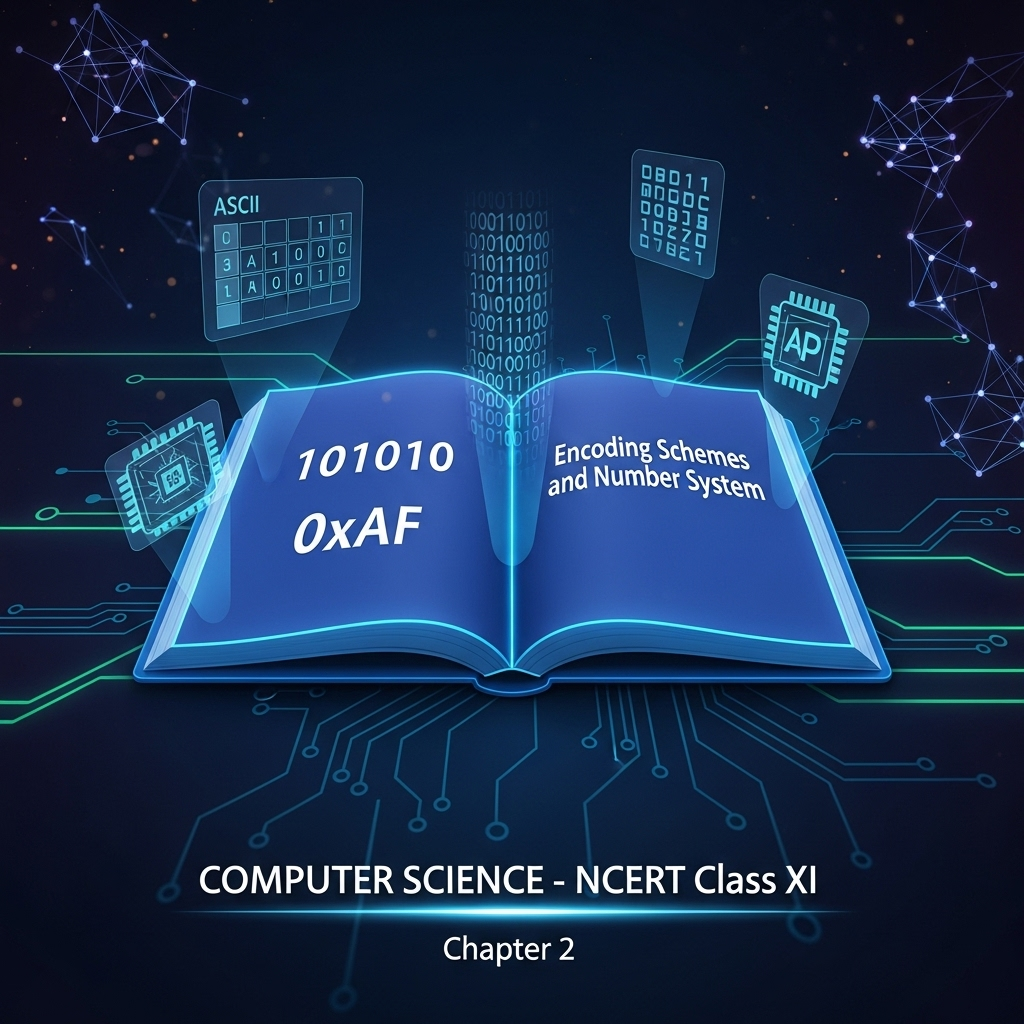Encoding Schemes and Number System – NCERT Class 11 Computer Science Chapter 2 – ASCII, ISCII, UNICODE, Binary, Octal, Decimal, Hexadecimal
Explains how character encoding allows computers to interpret human-readable input using schemes like ASCII, ISCII, and UNICODE. Covers the fundamentals of binary, octal, decimal, and hexadecimal number systems, including positional values, conversion methods, and real-world applications such as text processing and color representation.
Updated: 1 month ago

Encoding Schemes and Number System
Chapter 2: Enhanced NCERT Class 11 Guide | Precise Notes from PDF, More Diagrams, 30 Q&A & Quiz 2025
Enhanced Full Chapter Summary & Precise Notes from NCERT PDF
Overview & Key Concepts
Exact Definition: "The mechanism of converting data into an equivalent cipher using specific code is called encoding."
- Introduction: Keys mapped to codes (e.g., 'A' → 65 decimal → 01000001 binary); Hindi 'अ' → 0905 hex → 0000100100000101 binary. Einstein quote on Indian numerals.
- Chapter Structure: Encoding (ASCII/ISCII/Unicode), Number Systems (Decimal/Binary/Octal/Hex), Conversions (Integer/Fractional).
- 2025 Relevance: Unicode for multilingual AI; Hex in web colors/RGB for digital design.
2.1 Introduction to Encoding
Precise: Computers understand binary; Keys → Unique code → Binary. Encoding standardizes for interoperability.
Precise Fig 2.1: Encoding of Data Entered Using Keyboard (SVG)
2.1.1 ASCII
Exact: "Developed in 1960s for standardising character representation... 7-bit (128 chars, English only)." Table 2.1: Space=32, A=65, a=97. Example: DATA → ASCII 68,65,84,65 → Binary 1000100 1000001 1010100 1000001 (Table 2.2).
| Character | Decimal | Character | Decimal |
|---|---|---|---|
| Space | 32 | A | 65 |
| ! | 33 | B | 66 |
| @ | 64 | a | 97 |
2.1.2 ISCII
Precise: "8-bit (256 chars) for Indian scripts... Retains 128 ASCII, 128 for aksharas (160-255)." Developed mid-1980s.
2.1.3 Unicode
Exact: "Unique number for every character... Independent of device/OS/software. Encodings: UTF-8/16/32 (superset of ASCII)." Table 2.3: Devanagari अ=0905 hex, etc. Activity 2.1: Fonts like Mangal for Hindi Unicode.
Think & Reflect: UTF-32 uses 32 bits/char (fixed, more space) vs UTF-16 (16/32 variable) or UTF-8 (8-32 variable).
| Character | Hex | Character | Hex |
|---|---|---|---|
| अ | 0905 | क | 0915 |
| आ | 0906 | ख | 0916 |
| ॥ | 0965 | ० | 0966 |
2.2 Number System
Precise: Method to represent numbers; Base=radix (# unique literals). Positional: Value= symbol × base^position. Fig 2.2: Binary(2:0-1), Octal(8:0-7), Decimal(10:0-9), Hex(16:0-9,A-F).
Precise Fig 2.2: Four Different Number Systems (SVG)
Precise Fig 2.3: Computation of Decimal 123.45 (SVG)
2.2.1 Decimal: Base-10; Positional powers (Fig 2.4: 237.25=2×10² + ...).
Precise Fig 2.4: Positional Value for Decimal 237.25 (SVG)
2.2.2 Binary: Base-2 (0/1); Transistor ON/OFF. E.g., 0-9 decimal binaries.
| Decimal | Binary |
|---|---|
| 0 | 0 |
| 5 | 101 |
| 9 | 1001 |
2.2.3 Octal: Base-8 (0-7); Groups of 3 bits (2^3=8).
2.2.4 Hex: Base-16 (0-9,A-F); Groups of 4 bits (2^4=16).
| Hex | Decimal | Binary |
|---|---|---|
| A | 10 | 1010 |
| F | 15 | 1111 |
2.2.5 Hex Applications: Memory addresses (16-bit binary → C0F1 hex); Colors (RGB 24-bit → #FF0000 red).
| Color | Decimal | Binary | Hex |
|---|---|---|---|
| Black | (0,0,0) | (00...) | (00,00,00) |
| Red | (255,0,0) | (1111...) | (FF,00,00) |
2.3 Conversions
Precise: Detailed in dedicated section.
Enhanced Features
Precise PDF quotes, derivations (positional b^n), SVGs (Figs 2.1-2.7), Unicode table subset, 30 Q&A (mark-based), 10-Q quiz. 2025: Focus on Unicode for global apps.
Exam Tips
Practice conversions with steps; Draw positional diagrams; Explain why 3/4 bits for Oct/Hex (2^3=8, 2^4=16).

Group Discussions
No forum posts available.


